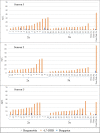Strategies to Produce Grapefruit-Like Citrus Varieties With a Low Furanocoumarin Content and Distinctive Flavonoid Profiles
- PMID: 33719319
- PMCID: PMC7943927
- DOI: 10.3389/fpls.2021.640512
Strategies to Produce Grapefruit-Like Citrus Varieties With a Low Furanocoumarin Content and Distinctive Flavonoid Profiles
Abstract
Pummelos and hybrids, such as grapefruits, have high furanocoumarin and low flavonoid contents. Furanocoumarins interact negatively with certain drugs, while flavonoids are antioxidant compounds with health benefits. To obtain new grapefruit-like varieties with low furanocoumarin and high flavonoid contents, diploid and triploid hybrid populations from crosses between diploid and tetraploid "Clemenules" clementine and diploid "Pink" pummelo were recovered and analyzed. With regard to furanocoumarins, triploids produce less bergapten, bergamottin and 6,7-DHB than diploids. Regarding flavonoids, triploids yielded more eriocitrin, narirutin, hesperidin and neohesperidin than diploids, whereas no differences were observed in neoeriocitrin and naringin. These results indicate that, the strategy to recover triploid hybrids by 4x × 2x crosses is more appropriate than the recovery of diploid hybrids by 2x × 2x crosses for obtaining grapefruit-like varieties of citrus with lower furanocoumarin and higher flavonoid contents.
Keywords: 6,7-dihydroxybergamottin; antioxidants; breeding; citrus; mandarin; naringin; pummelo; triploids.
Copyright © 2021 Garcia-Lor, Bermejo, Morales, Hernández, Medina, Cuenca, Navarro and Aleza.
Conflict of interest statement
The authors declare that the research was conducted in the absence of any commercial or financial relationships that could be construed as a potential conflict of interest.
Figures




Similar articles
-
Flavonoid composition and antioxidant activities of Chinese local pummelo (Citrus grandis Osbeck.) varieties.Food Chem. 2014 Oct 15;161:230-8. doi: 10.1016/j.foodchem.2014.04.001. Epub 2014 Apr 12. Food Chem. 2014. PMID: 24837945
-
Recovering triploid citrus hybrids from 2x × 2x sexual crosses with the aid of embryo rescue and flow cytometry in Turkey.Mol Biol Rep. 2022 Jun;49(6):5625-5634. doi: 10.1007/s11033-022-07555-2. Epub 2022 May 31. Mol Biol Rep. 2022. PMID: 35641712
-
Inheritance in doubled-diploid clementine and comparative study with SDR unreduced gametes of diploid clementine.Plant Cell Rep. 2016 Aug;35(8):1573-86. doi: 10.1007/s00299-016-1972-4. Epub 2016 Apr 2. Plant Cell Rep. 2016. PMID: 27038940
-
Chemistry and health effects of furanocoumarins in grapefruit.J Food Drug Anal. 2017 Jan;25(1):71-83. doi: 10.1016/j.jfda.2016.11.008. Epub 2016 Dec 6. J Food Drug Anal. 2017. PMID: 28911545 Free PMC article. Review.
-
[Grapefruit juice and drugs: a hazardous combination?].Therapie. 2002 Sep-Oct;57(5):432-45. Therapie. 2002. PMID: 12611197 Review. French.
Cited by
-
Recovery of Naringin-Rich Flavonoid Extracts from Agroresidues with Anxiolytic- and Antidepressant-like Effects in Mice.Molecules. 2022 Dec 3;27(23):8507. doi: 10.3390/molecules27238507. Molecules. 2022. PMID: 36500599 Free PMC article.
-
Morphological and metabolic changes in Changshan Huyou (Citrus changshan-huyou) following natural tetraploidization.BMC Plant Biol. 2025 Mar 8;25(1):301. doi: 10.1186/s12870-025-06293-4. BMC Plant Biol. 2025. PMID: 40055582 Free PMC article.
-
Pollen Development and Viability in Diploid and Doubled Diploid Citrus Species.Front Plant Sci. 2022 Apr 25;13:862813. doi: 10.3389/fpls.2022.862813. eCollection 2022. Front Plant Sci. 2022. PMID: 35557738 Free PMC article.
References
-
- Abbas M., Saeed F., Anjum F. M., Afzaal M., Tufail T., Bashir M. S., et al. (2017). Natural polyphenols: An overview. Int. J. Food Propert. 20 1689–1699. 10.1080/10942912.2016.1220393 - DOI
-
- Ahmed D., Evrard J. C., Ollitrault P., Froelicher Y. (2020). The effect of cross direction and ploidy level on phenotypic variation of reciprocal diploid and triploid mandarin hybrids. Tree Genet. Genomes 16:25. 10.1007/s11295-020-1417-7 - DOI
LinkOut - more resources
Full Text Sources
Other Literature Sources

